window SATURN VUE 2008 User Guide
[x] Cancel search | Manufacturer: SATURN, Model Year: 2008, Model line: VUE, Model: SATURN VUE 2008Pages: 412, PDF Size: 2.78 MB
Page 90 of 412
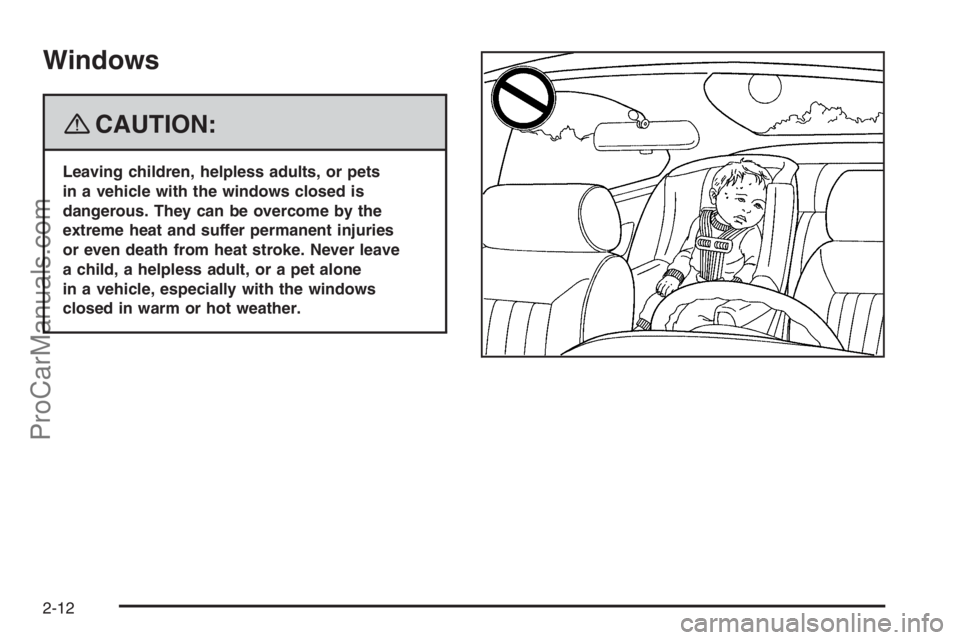
Windows
{CAUTION:
Leaving children, helpless adults, or pets
in a vehicle with the windows closed is
dangerous. They can be overcome by the
extreme heat and suffer permanent injuries
or even death from heat stroke. Never leave
a child, a helpless adult, or a pet alone
in a vehicle, especially with the windows
closed in warm or hot weather.
2-12
ProCarManuals.com
Page 91 of 412
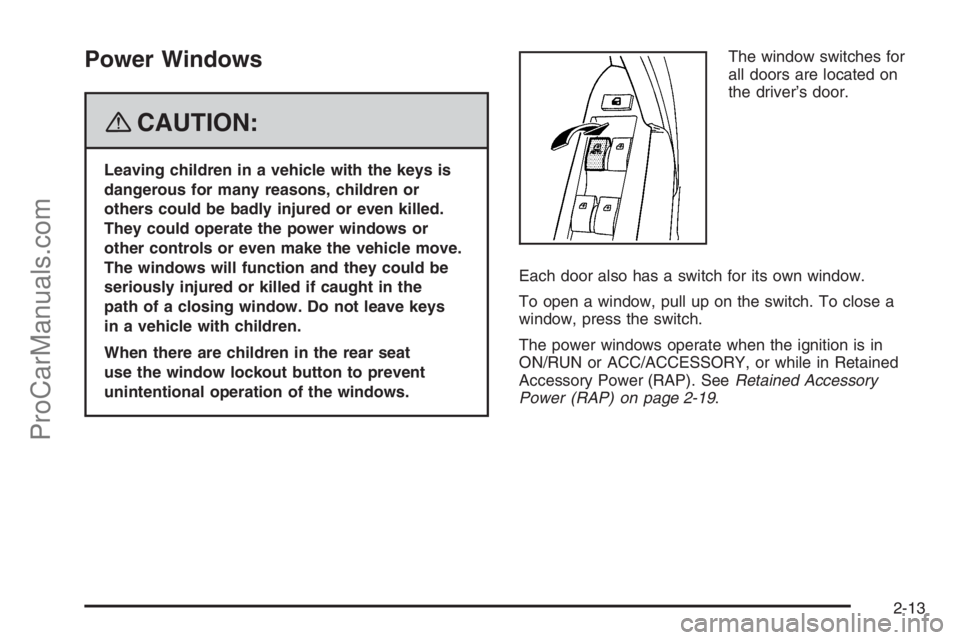
Power Windows
{CAUTION:
Leaving children in a vehicle with the keys is
dangerous for many reasons, children or
others could be badly injured or even killed.
They could operate the power windows or
other controls or even make the vehicle move.
The windows will function and they could be
seriously injured or killed if caught in the
path of a closing window. Do not leave keys
in a vehicle with children.
When there are children in the rear seat
use the window lockout button to prevent
unintentional operation of the windows.The window switches for
all doors are located on
the driver’s door.
Each door also has a switch for its own window.
To open a window, pull up on the switch. To close a
window, press the switch.
The power windows operate when the ignition is in
ON/RUN or ACC/ACCESSORY, or while in Retained
Accessory Power (RAP). SeeRetained Accessory
Power (RAP) on page 2-19.
2-13
ProCarManuals.com
Page 92 of 412

Express-Down Window
The driver’s window switch has an express-down
feature that allows the window to be lowered without
holding the switch. Press the switch part way, and
the driver’s window will open a small amount. Press the
switch down all the way and release it and the window
will go down automatically.
To stop the window while it is lowering, press and
release the switch.
Window Lockout
o
(Window Lockout):Your vehicle has a lockout
feature to prevent rear seat passengers from operating
the windows. Press the lockout button, located with the
power window switches, to turn the feature on and off.
Sun Visors
To block out glare, swing the sun visor down. You can
also detach the driver’s sun visor from the center mount
and slide it along the rod from side-to-side for greater
coverage.
Visor Vanity Mirrors
On vehicles with covered visor vanity mirrors,
pull down the sun visor to access the vanity mirror.
Lighted Visor Vanity Mirrors
On vehicles with lighted visor vanity mirrors, pull down
the sun visor to access the vanity mirror. The lights
will come on when you lift the cover.
Theft-Deterrent Systems
Vehicle theft is big business, especially in some cities.
This vehicle has theft-deterrent features, however,
they do not make it impossible to steal.
Content Theft-Deterrent
Your vehicle may have a content theft-deterrent
alarm system.
The security light is
located near the center
of the instrument panel.
United States shown,
Canada similar
2-14
ProCarManuals.com
Page 93 of 412

To arm the theft-deterrent system, press the lock button
on the RKE transmitter when all doors and the hood
(vehicles started with the remote start feature only)
are closed. The security light will come on solid
for approximately 30 seconds and then �ashes slowly.
If the lock button on the RKE transmitter is pressed
a second time, the theft-deterrent system will activate
immediately, bypassing the 30 second delay. The
content theft deterrent alarm is not armed until the
security light �ashes slowly.
If any door, liftgate or the hood (vehicles started with
the remote start feature only) are opened without using
the key or pressing the unlock button on the RKE
transmitter, the exterior lamps �ash and the horn will
sound for about 30 seconds. If the lock or unlock
button on the RKE transmitter is not pressed, the alarm
sounds and periodically repeats. If the system does
not operate as described above, see your dealer/retailer
for service.
The theft-deterrent system also activates if you lock
the doors with a key.
To avoid setting off the alarm by accident, always
unlock a door with the RKE transmitter or a key.
Unlocking a door any other way will set off the
alarm if the system has been armed.If you set off the alarm by accident, turn off the alarm
by pressing lock or unlock on the RKE transmitter or by
placing the key in the ignition and turning it to START.
Testing the Alarm
To test the alarm:
1. From inside the vehicle, lower the driver’s window
and open the driver’s door.
2. Get out of the vehicle, close the door and activate
the system by locking the doors with the RKE
transmitter.
3. Wait for the security light to �ash slowly.
4. Then reach in through the window, unlock the
door with the manual door lock and open the
door. This should set off the alarm.
If the alarm does not sound when it should, but the
vehicle’s headlamps �ash, check to see if the horn
works. The horn fuse may be blown. To replace the
fuse, seeFuses and Circuit Breakers on page 5-97.
If the alarm does not sound or the vehicle’s headlamps
do not �ash, see your dealer/retailer for service.
2-15
ProCarManuals.com
Page 97 of 412
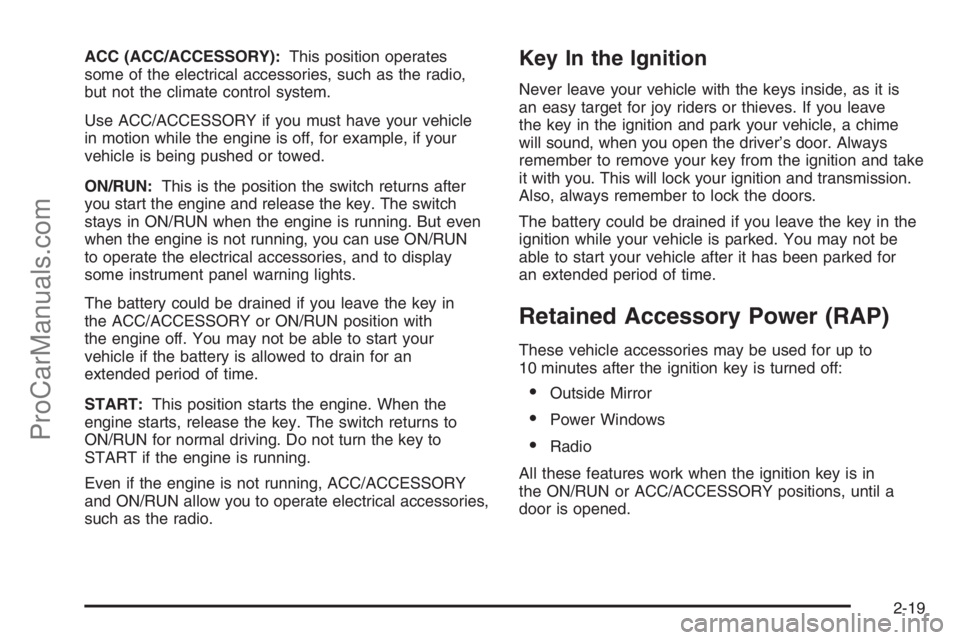
ACC (ACC/ACCESSORY):This position operates
some of the electrical accessories, such as the radio,
but not the climate control system.
Use ACC/ACCESSORY if you must have your vehicle
in motion while the engine is off, for example, if your
vehicle is being pushed or towed.
ON/RUN:This is the position the switch returns after
you start the engine and release the key. The switch
stays in ON/RUN when the engine is running. But even
when the engine is not running, you can use ON/RUN
to operate the electrical accessories, and to display
some instrument panel warning lights.
The battery could be drained if you leave the key in
the ACC/ACCESSORY or ON/RUN position with
the engine off. You may not be able to start your
vehicle if the battery is allowed to drain for an
extended period of time.
START:This position starts the engine. When the
engine starts, release the key. The switch returns to
ON/RUN for normal driving. Do not turn the key to
START if the engine is running.
Even if the engine is not running, ACC/ACCESSORY
and ON/RUN allow you to operate electrical accessories,
such as the radio.Key In the Ignition
Never leave your vehicle with the keys inside, as it is
an easy target for joy riders or thieves. If you leave
the key in the ignition and park your vehicle, a chime
will sound, when you open the driver’s door. Always
remember to remove your key from the ignition and take
it with you. This will lock your ignition and transmission.
Also, always remember to lock the doors.
The battery could be drained if you leave the key in the
ignition while your vehicle is parked. You may not be
able to start your vehicle after it has been parked for
an extended period of time.
Retained Accessory Power (RAP)
These vehicle accessories may be used for up to
10 minutes after the ignition key is turned off:
Outside Mirror
Power Windows
Radio
All these features work when the ignition key is in
the ON/RUN or ACC/ACCESSORY positions, until a
door is opened.
2-19
ProCarManuals.com
Page 110 of 412
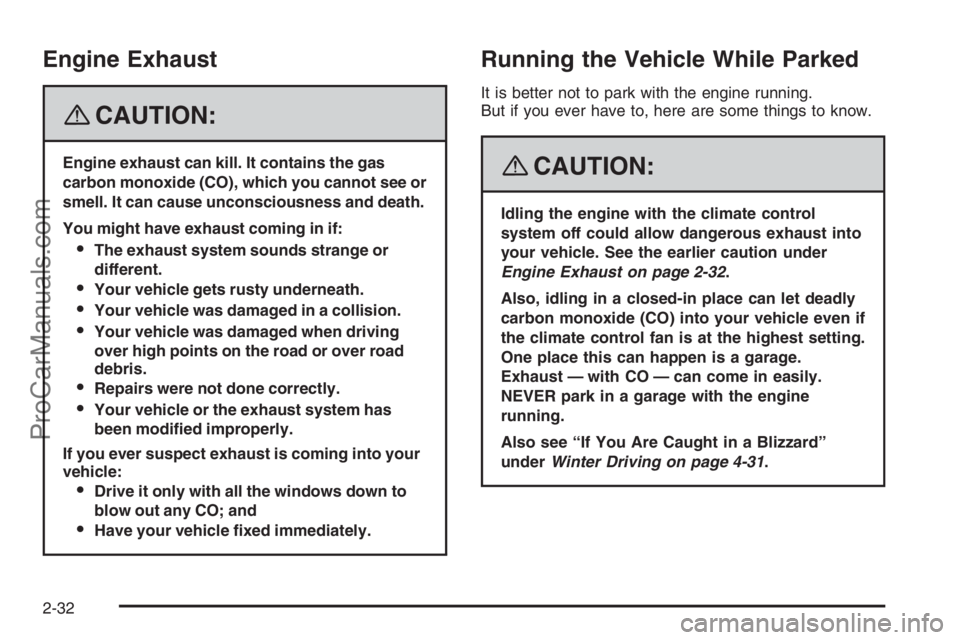
Engine Exhaust
{CAUTION:
Engine exhaust can kill. It contains the gas
carbon monoxide (CO), which you cannot see or
smell. It can cause unconsciousness and death.
You might have exhaust coming in if:
The exhaust system sounds strange or
different.
Your vehicle gets rusty underneath.
Your vehicle was damaged in a collision.
Your vehicle was damaged when driving
over high points on the road or over road
debris.
Repairs were not done correctly.
Your vehicle or the exhaust system has
been modi�ed improperly.
If you ever suspect exhaust is coming into your
vehicle:
Drive it only with all the windows down to
blow out any CO; and
Have your vehicle �xed immediately.
Running the Vehicle While Parked
It is better not to park with the engine running.
But if you ever have to, here are some things to know.
{CAUTION:
Idling the engine with the climate control
system off could allow dangerous exhaust into
your vehicle. See the earlier caution under
Engine Exhaust on page 2-32.
Also, idling in a closed-in place can let deadly
carbon monoxide (CO) into your vehicle even if
the climate control fan is at the highest setting.
One place this can happen is a garage.
Exhaust — with CO — can come in easily.
NEVER park in a garage with the engine
running.
Also see “If You Are Caught in a Blizzard”
underWinter Driving on page 4-31.
2-32
ProCarManuals.com
Page 129 of 412
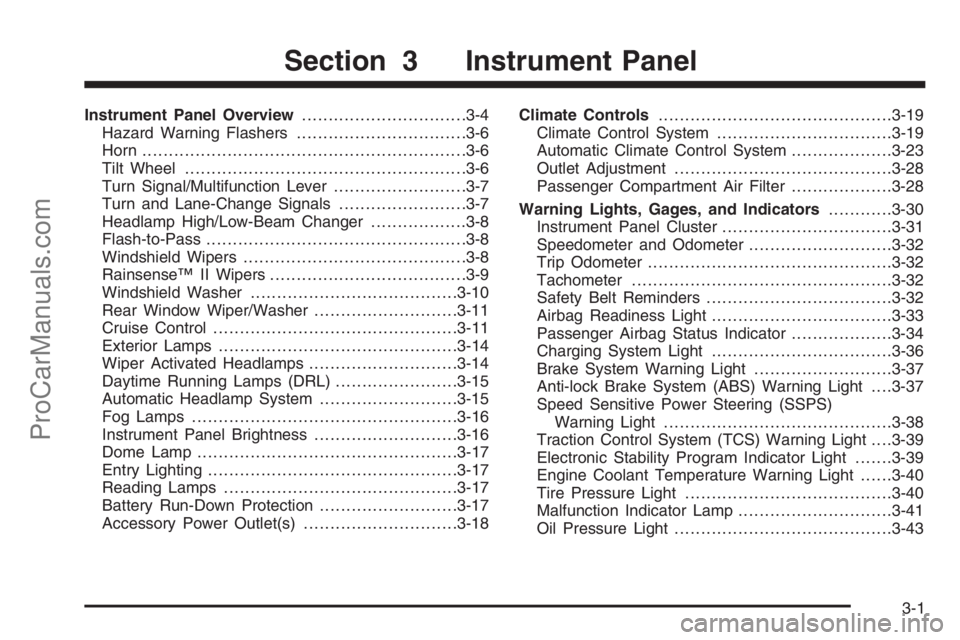
Instrument Panel Overview...............................3-4
Hazard Warning Flashers................................3-6
Horn .............................................................3-6
Tilt Wheel.....................................................3-6
Turn Signal/Multifunction Lever.........................3-7
Turn and Lane-Change Signals........................3-7
Headlamp High/Low-Beam Changer..................3-8
Flash-to-Pass.................................................3-8
Windshield Wipers..........................................3-8
Rainsense™ II Wipers.....................................3-9
Windshield Washer.......................................3-10
Rear Window Wiper/Washer...........................3-11
Cruise Control..............................................3-11
Exterior Lamps.............................................3-14
Wiper Activated Headlamps............................3-14
Daytime Running Lamps (DRL).......................3-15
Automatic Headlamp System..........................3-15
Fog Lamps ..................................................3-16
Instrument Panel Brightness...........................3-16
Dome Lamp .................................................3-17
Entry Lighting...............................................3-17
Reading Lamps............................................3-17
Battery Run-Down Protection..........................3-17
Accessory Power Outlet(s).............................3-18Climate Controls............................................3-19
Climate Control System.................................3-19
Automatic Climate Control System...................3-23
Outlet Adjustment.........................................3-28
Passenger Compartment Air Filter...................3-28
Warning Lights, Gages, and Indicators............3-30
Instrument Panel Cluster................................3-31
Speedometer and Odometer...........................3-32
Trip Odometer..............................................3-32
Tachometer.................................................3-32
Safety Belt Reminders...................................3-32
Airbag Readiness Light..................................3-33
Passenger Airbag Status Indicator...................3-34
Charging System Light..................................3-36
Brake System Warning Light..........................3-37
Anti-lock Brake System (ABS) Warning Light. . . .3-37
Speed Sensitive Power Steering (SSPS)
Warning Light...........................................3-38
Traction Control System (TCS) Warning Light. . . .3-39
Electronic Stability Program Indicator Light.......3-39
Engine Coolant Temperature Warning Light......3-40
Tire Pressure Light.......................................3-40
Malfunction Indicator Lamp.............................3-41
Oil Pressure Light.........................................3-43
Section 3 Instrument Panel
3-1
ProCarManuals.com
Page 133 of 412
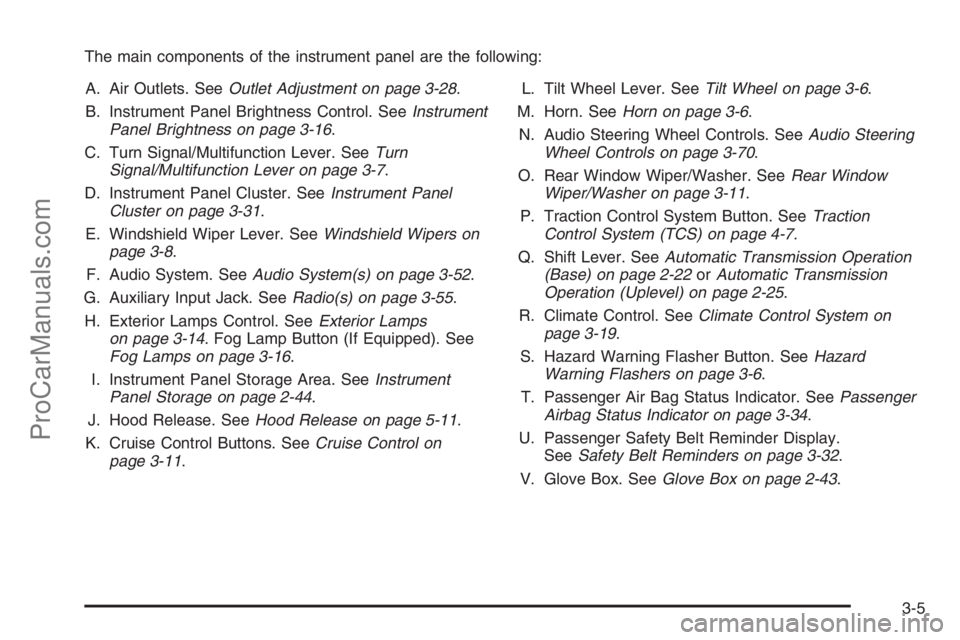
The main components of the instrument panel are the following:
A. Air Outlets. SeeOutlet Adjustment on page 3-28.
B. Instrument Panel Brightness Control. SeeInstrument
Panel Brightness on page 3-16.
C. Turn Signal/Multifunction Lever. SeeTurn
Signal/Multifunction Lever on page 3-7.
D. Instrument Panel Cluster. SeeInstrument Panel
Cluster on page 3-31.
E. Windshield Wiper Lever. SeeWindshield Wipers on
page 3-8.
F. Audio System. SeeAudio System(s) on page 3-52.
G. Auxiliary Input Jack. SeeRadio(s) on page 3-55.
H. Exterior Lamps Control. SeeExterior Lamps
on page 3-14. Fog Lamp Button (If Equipped). See
Fog Lamps on page 3-16.
I. Instrument Panel Storage Area. SeeInstrument
Panel Storage on page 2-44.
J. Hood Release. SeeHood Release on page 5-11.
K. Cruise Control Buttons. SeeCruise Control on
page 3-11.L. Tilt Wheel Lever. SeeTilt Wheel on page 3-6.
M. Horn. SeeHorn on page 3-6.
N. Audio Steering Wheel Controls. SeeAudio Steering
Wheel Controls on page 3-70.
O. Rear Window Wiper/Washer. SeeRear Window
Wiper/Washer on page 3-11.
P. Traction Control System Button. SeeTraction
Control System (TCS) on page 4-7.
Q. Shift Lever. SeeAutomatic Transmission Operation
(Base) on page 2-22orAutomatic Transmission
Operation (Uplevel) on page 2-25.
R. Climate Control. SeeClimate Control System on
page 3-19.
S. Hazard Warning Flasher Button. SeeHazard
Warning Flashers on page 3-6.
T. Passenger Air Bag Status Indicator. SeePassenger
Airbag Status Indicator on page 3-34.
U. Passenger Safety Belt Reminder Display.
SeeSafety Belt Reminders on page 3-32.
V. Glove Box. SeeGlove Box on page 2-43.
3-5
ProCarManuals.com
Page 138 of 412
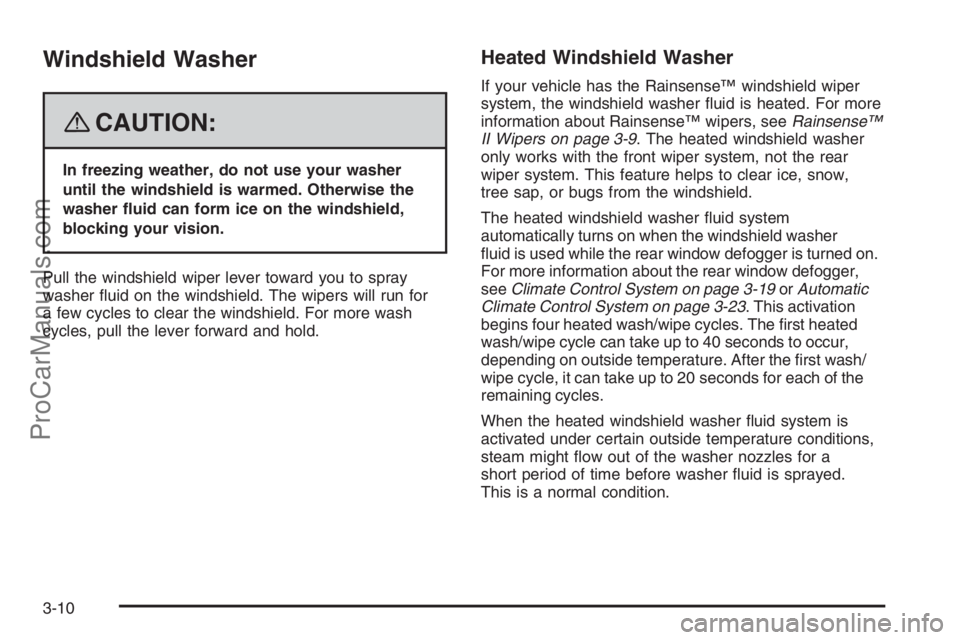
Windshield Washer
{CAUTION:
In freezing weather, do not use your washer
until the windshield is warmed. Otherwise the
washer �uid can form ice on the windshield,
blocking your vision.
Pull the windshield wiper lever toward you to spray
washer �uid on the windshield. The wipers will run for
a few cycles to clear the windshield. For more wash
cycles, pull the lever forward and hold.
Heated Windshield Washer
If your vehicle has the Rainsense™ windshield wiper
system, the windshield washer �uid is heated. For more
information about Rainsense™ wipers, seeRainsense™
II Wipers on page 3-9. The heated windshield washer
only works with the front wiper system, not the rear
wiper system. This feature helps to clear ice, snow,
tree sap, or bugs from the windshield.
The heated windshield washer �uid system
automatically turns on when the windshield washer
�uid is used while the rear window defogger is turned on.
For more information about the rear window defogger,
seeClimate Control System on page 3-19orAutomatic
Climate Control System on page 3-23. This activation
begins four heated wash/wipe cycles. The �rst heated
wash/wipe cycle can take up to 40 seconds to occur,
depending on outside temperature. After the �rst wash/
wipe cycle, it can take up to 20 seconds for each of the
remaining cycles.
When the heated windshield washer �uid system is
activated under certain outside temperature conditions,
steam might �ow out of the washer nozzles for a
short period of time before washer �uid is sprayed.
This is a normal condition.
3-10
ProCarManuals.com
Page 139 of 412
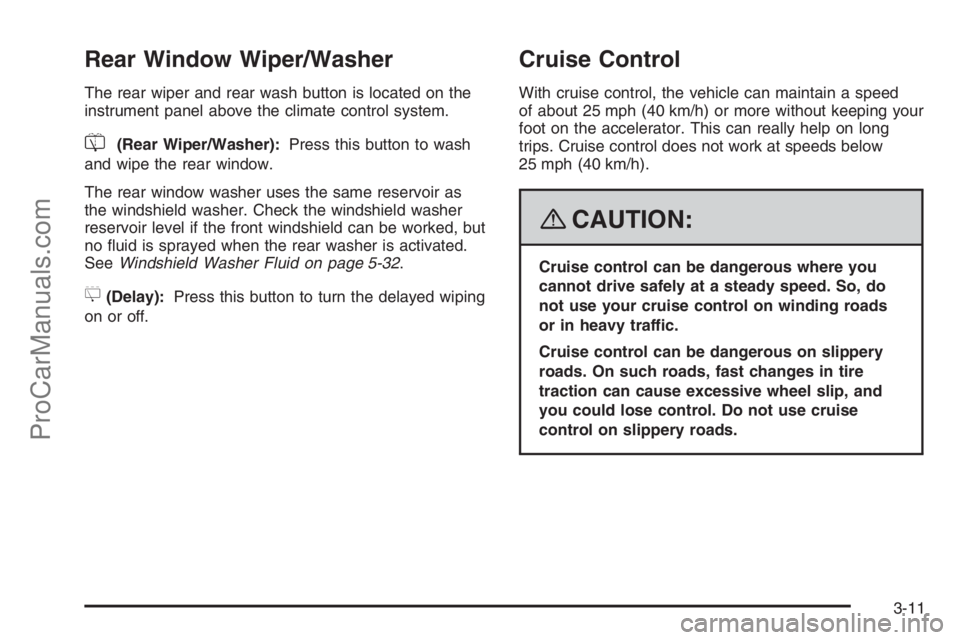
Rear Window Wiper/Washer
The rear wiper and rear wash button is located on the
instrument panel above the climate control system.
=(Rear Wiper/Washer):Press this button to wash
and wipe the rear window.
The rear window washer uses the same reservoir as
the windshield washer. Check the windshield washer
reservoir level if the front windshield can be worked, but
no �uid is sprayed when the rear washer is activated.
SeeWindshield Washer Fluid on page 5-32.
5(Delay):Press this button to turn the delayed wiping
on or off.
Cruise Control
With cruise control, the vehicle can maintain a speed
of about 25 mph (40 km/h) or more without keeping your
foot on the accelerator. This can really help on long
trips. Cruise control does not work at speeds below
25 mph (40 km/h).
{CAUTION:
Cruise control can be dangerous where you
cannot drive safely at a steady speed. So, do
not use your cruise control on winding roads
or in heavy traffic.
Cruise control can be dangerous on slippery
roads. On such roads, fast changes in tire
traction can cause excessive wheel slip, and
you could lose control. Do not use cruise
control on slippery roads.
3-11
ProCarManuals.com